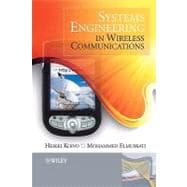
Note: Supplemental materials are not guaranteed with Rental or Used book purchases.
Purchase Benefits
What is included with this book?
Professor Heikki Koivo works at the Control Engineering Laboratory at Helsinki University of Technology.
He has been an Editorial board member on several journals including, the International Journal of Adaptive Control and Signal Processing and the Journal of Systems and Control Engineering.
| Chapter Introduction | |
| Introduction to Telecommunication | |
| The quality of services (QoS) parameters | |
| Multiple Access Techniques | |
| Chapter Feedback Control Basics | |
| Introduction | |
| Feedback Control | |
| Relay control (ON-OFF control) | |
| Proportional-Integral-Derivative (PID) Control | |
| Proportional control (P Control) | |
| Integral controller (I control) | |
| Proportional-Integral controller (PI control) | |
| Proportional Derivative Controller (PD controller) | |
| Proportional-Integral-Derivative Controller (PID controller) | |
| Practical issues | |
| Tuning Of Pid Controllers | |
| Digital Implementation Of A Pid Controller | |
| Phase-Locked Loop | |
| State Space Representation | |
| Kalman Filter | |
| Linear Kalman Filter | |
| Fuzzy Control | |
| Stability | |
| Summary | |
| Chapter Channel Modeling | |
| Introduction | |
| Large-scale propagation models | |
| Small-scale propagation models and Statistical multipath channel models | |
| Summary | |
| Chapter Channel Estimation And Prediction | |
| Introduction | |
| Linear time-variant (LTV) channel model | |
| Multivariable case | |
| Simulation of LTV systems | |
| Discrete-time models | |
| Discrete-time models with noise | |
| Least squares identification | |
| Minimum variance prediction | |
| Self-tuning predictor | |
| Summary | |
| Chapter Power Control Part 1: Linear Algebra Perspective | |
| Introduction | |
| Centralized Power Control | |
| Graphical Description of Power Control | |
| Distributed Power Control Algorithms | |
| Chapter Power control 2: Control engineering perspective | |
| Introduction | |
| Issues in uplink power control | |
| Upper link power control with a relay controller | |
| Example 6-1: Relay control | |
| PID control | |
| Example 6-3: PID control tuning with optimization | |
| Example 6-4: PID power control | |
| Self-tuning predictive power control algorithm | |
| Self-tuning power control | |
| Example 6-4 Self-tuning power control | |
| Fuzzy power control | |
| Summary | |
| chapter Admission And Load Control | |
| Introduction to Admission Control (AC) | |
| Theoretical Analysis of Centralized Admission Control | |
| Non-Interactive Distributed Admission Control (NIDAC) | |
| Interactive Distributed Admission Control (IDAC) | |
| Admission Control in UMTS | |
| Admission Control for Non-real time Application | |
| Load Control (LC) | |
| Chapter Combining Different Radio Resources | |
| Some radio resources interrelations | |
| Power and rate control | |
| Mathematical formulation of the RRM problem in MO framework | |
| Chapter Smart Antennas | |
| Smart Antennas and Adaptation | |
| Spatial-Temporal Processing | |
| Joining Radio Resources with Beamforming | |
| Multiple Input Multiple Output (MIMO) Antennas | |
| Chapter Cognitive Radios and Networks | |
| Concepts of Cognitive Radios | |
| Spectrum Attention of Cognitive Radios | |
| Direct Spectrum Sensing | |
| Cognitive Radio Networks and Game Theory | |
| System Engineering and Cognitive Radios | |
| Table of Contents provided by Publisher. All Rights Reserved. |
The New copy of this book will include any supplemental materials advertised. Please check the title of the book to determine if it should include any access cards, study guides, lab manuals, CDs, etc.
The Used, Rental and eBook copies of this book are not guaranteed to include any supplemental materials. Typically, only the book itself is included. This is true even if the title states it includes any access cards, study guides, lab manuals, CDs, etc.